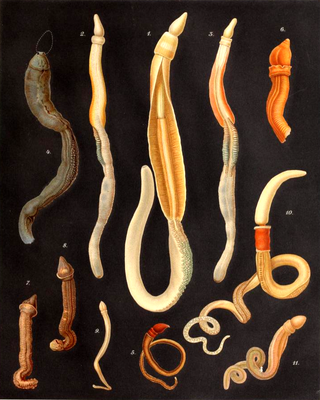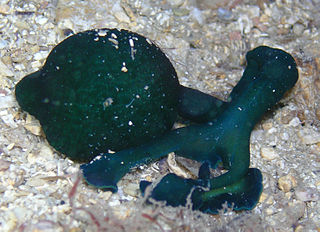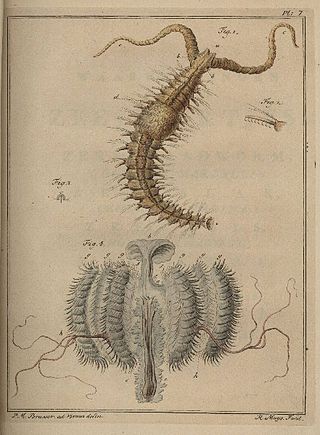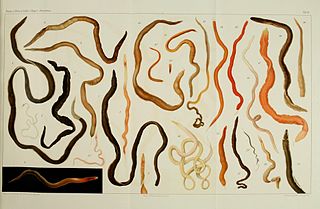
The Sipuncula or Sipunculida is a class containing about 162 species of unsegmented marine annelid worms. The name Sipuncula is from the genus name Sipunculus, and comes from the Latin siphunculus meaning a "small tube".

The Echiura, or spoon worms, are a small group of marine animals. Once treated as a separate phylum, they are now considered to belong to Annelida. Annelids typically have their bodies divided into segments, but echiurans have secondarily lost their segmentation. The majority of echiurans live in burrows in soft sediment in shallow water, but some live in rock crevices or under boulders, and there are also deep sea forms. More than 230 species have been described. Spoon worms are cylindrical, soft-bodied animals usually possessing a non-retractable proboscis which can be rolled into a scoop-shape to feed. In some species the proboscis is ribbon-like, longer than the trunk and may have a forked tip. Spoon worms vary in size from less than a centimetre in length to more than a metre.

Nemertea is a phylum of animals also known as ribbon worms or proboscis worms, consisting of 1300 known species. Most ribbon worms are very slim, usually only a few millimeters wide, although a few have relatively short but wide bodies. Many have patterns of yellow, orange, red and green coloration. The foregut, stomach and intestine run a little below the midline of the body, the anus is at the tip of the tail, and the mouth is under the front. A little above the gut is the rhynchocoel, a cavity which mostly runs above the midline and ends a little short of the rear of the body. All species have a proboscis which lies in the rhynchocoel when inactive but everts to emerge just above the mouth to capture the animal's prey with venom. A highly extensible muscle in the back of the rhynchocoel pulls the proboscis in when an attack ends. A few species with stubby bodies filter feed and have suckers at the front and back ends, with which they attach to a host.

Polychaeta is a paraphyletic class of generally marine annelid worms, commonly called bristle worms or polychaetes. Each body segment has a pair of fleshy protrusions called parapodia that bear many bristles, called chaetae, which are made of chitin. More than 10,000 species are described in this class. Common representatives include the lugworm and the sandworm or clam worm Alitta.

The acorn worms or Enteropneusta are a hemichordate class of invertebrates consisting of one order of the same name. The closest non-hemichordate relatives of the Enteropneusta are the echinoderms. There are 111 known species of acorn worm in the world, the main species for research being Saccoglossus kowalevskii. Two families—Harrimaniidae and Ptychoderidae—separated at least 370 million years ago.

Urechis unicinctus, known as the fat innkeeper worm or penis fish, is a species of marine spoon worm in East Asia. It is found in Bohai Gulf of China and off the Korean and Hokkaido coasts. It is not to be confused with a closely related species, Urechis caupo, which occurs on the western coast of North America and shares common names. The body is about 10–30 cm long, cylindrical in shape and yellowish-brown in color. On the surface of the body there are many small papillae.

Bonellia viridis, the green spoonworm, is a marine worm noted for displaying exceptional sexual dimorphism and for the biocidal properties of a pigment in its skin.
Listriolobus pelodes is a species of marine spoon worm. It is found in shallow seas in the North East Pacific off the coast of California. It lives in a burrow in soft sediments.

Scolelepis squamata is a species of polychaete worm in the family Spionidae. It occurs on the lower shore of coasts on either side of the Atlantic Ocean.

Polydora ciliata is a species of annelid worm in the family Spionidae, commonly known as a bristleworm. It is a burrowing worm and is found in the northeastern Atlantic Ocean and some other parts of the world.
Saccoglossus bromophenolosus is a species of acorn worm occurring in the northwestern Atlantic Ocean and the northeastern Pacific Ocean. It grows to a length of about 20 cm (8 in) and lives in a burrow in soft sediment in the intertidal and subtidal zones. The scientific name refers to 2,4-dibromophenol, a secondary metabolite present in this worm.

Tubulanus superbus, commonly known as the football jersey worm, is a species of ribbon worm in the phylum Nemertea. Found in the northern Atlantic Ocean, the North Sea and the Mediterranean Sea, it occurs from the lower shore down to about 80 m (260 ft), on sand or gravel.

Cerebratulus lacteus, the milky nemertean or milky ribbon worm, is a proboscis worm in the family Lineidae. This ribbon worm has a wide geographical range on both sides of the northern Atlantic Ocean.

Cerebratulus marginatus is a proboscis worm in the family Lineidae. This ribbon worm has an Arctic distribution, and in the North Atlantic Ocean ranges as far south as Cape Cod and the Mediterranean Sea while in the Pacific Ocean it extends southwards to California.

Bonelliidae is a family of marine worms noted for being sexually dimorphic, with males being tiny in comparison with the females. They occupy burrows in the seabed in many parts of the world's oceans, often at great depths.

Urechis caupo is a species of spoon worm in the family Urechidae, commonly known as the innkeeper echiuran, the fat innkeeper worm, the innkeeper worm, or the penis fish. It is found in shallow water on the west coast of North America, between southern Oregon and Baja California, where it forms a U-shaped burrow in the sediment and feeds on plankton using a mucus net.

Ochetostoma erythrogrammon is a species of spoon worm in the family Thalassematidae. It is found in shallow water in the Atlantic Ocean, the Mediterranean Sea, and the Indian and Pacific Oceans, burrowing in soft sediment.

Echiurus echiurus is a species of spoon worm in the family Echiuridae. It is found in the North Atlantic Ocean and a subspecies is found in Alaska. It burrows into soft sediment and under boulders and stones in muddy places.
Ikeda taenioides is a species of spoon worm in the family Ikedidae. It is native to the northern Pacific Ocean where it is found in the subtidal waters around Japan.

Phyllodoce lineata is a species of polychaete worm in the family Phyllodocidae. It is native to the northeastern Atlantic Ocean and the Mediterranean Sea where it occurs in the intertidal and shallow sub-tidal zones on soft sediment.














